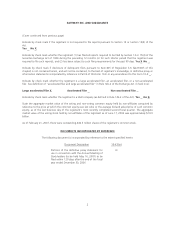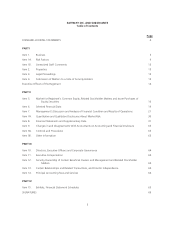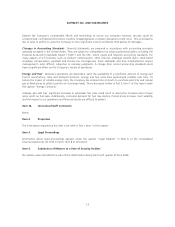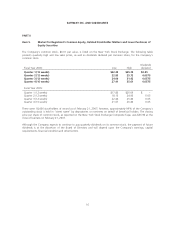Safeway 2006 Annual Report Download - page 29
Download and view the complete annual report
Please find page 29 of the 2006 Safeway annual report below. You can navigate through the pages in the report by either clicking on the pages listed below, or by using the keyword search tool below to find specific information within the annual report.SAFEWAY INC. AND SUBSIDIARIES
operational issues that result in limitations on gift cards available for sale in Blackhawk’s distribution
channels, or other factors that contribute to a shortfall in sales during this period could have an adverse
effect on the Company’s consolidated results of operations and financial condition;
• Blackhawk’s business depends on its ability to negotiate contract renewals with its key partners;
• Blackhawk has begun to expand internationally, and it may find a different business or competitive
environment in markets outside the U.S. that could adversely affect its profitability; and
• Blackhawk’s prospects could be adversely affected as a result of regulatory changes affecting the sales of gift
cards or other products that Blackhawk sells or plans to sell in the future.
Food Safety, Quality and Health Concerns We could be adversely affected if consumers lose confidence in the
safety and quality of certain food products. Adverse publicity about these types of concerns, whether valid or not, may
discourage consumers from buying our products or cause production and delivery disruptions. The real or perceived
sale of contaminated food products by us could result in product liability claims and a loss of consumer confidence,
which could have a material adverse effect on our sales and operations.
Economic Conditions that Impact Consumer Spending Our results of operations are sensitive to changes in
overall economic conditions that impact consumer spending, including discretionary spending. Future economic
conditions such as employment levels, business conditions, interest rates, energy and fuel costs and tax rates could
reduce consumer spending or change consumer purchasing habits. A general reduction in the level of consumer
spending or our inability to respond to shifting consumer attitudes regarding products, store location and other factors
could adversely affect our growth and profitability.
Unfavorable Changes in Government Regulation Our stores are subject to various federal, state, local and
foreign laws, regulations and administrative practices that affect our business. We must comply with numerous
provisions regulating health and sanitation standards, food labeling, equal employment opportunity, minimum wages,
and licensing for the sale of food, drugs and alcoholic beverages. We cannot predict the nature of future laws,
regulations, interpretations or applications, nor can we determine what effect either additional government
regulations or administrative orders, when and if promulgated, or disparate federal, state, local and foreign regulatory
schemes would have on our future business. They could, however, require the reformulation of certain products to
meet new standards, the recall or discontinuance of certain products not able to be reformulated, additional record
keeping, expanded documentation of the properties of certain products, expanded or different labeling, and/or
scientific substantiation. Any or all of such requirements could have an adverse effect on our results of operations and
financial condition.
Substantial Indebtedness We currently have, and expect to continue to have, a significant amount of debt, which
could adversely affect our financial health. As of December 30, 2006, we had approximately $5.9 billion in total
consolidated debt outstanding. This substantial indebtedness could increase our vulnerability to general adverse
economic and industry conditions. If debt markets do not permit us to refinance certain maturing debt, we may be
required to: dedicate a substantial portion of our cash flow from operations to payments on our indebtedness, thereby
reducing the availability of our cash flow to fund working capital, capital expenditures, acquisitions, development
efforts and other general corporate purposes; limit our flexibility in planning for, or reacting to, changes in our business;
place ourselves at a competitive disadvantage relative to our competitors that have less debt; and limit, along with the
financial and other restrictive covenants in the documents governing our indebtedness, among other things, our ability
to borrow additional funds. Changes in our credit ratings may have an adverse impact on our financing costs and
structure in future periods, such as the higher interest costs on future financings and our ability to participate in the
commercial paper market. Additionally, interest expense could be materially and adversely affected by changes in the
interest rate environment, changes in our credit rating, fluctuations in the amount of outstanding debt, decisions to
incur premiums on the early redemption of debt and any other factor that results in an increase in debt.
Retirement Plans We maintain defined benefit retirement plans for substantially all employees not participating in
multi-employer pension plans. Expenses from defined benefit pension plans may be significantly affected by changes
in the actual return on plan assets and actuarial assumptions.
11
























